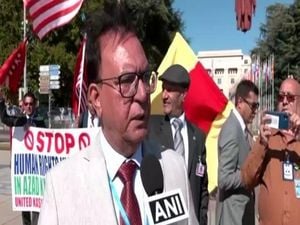The communities of Jefferson County, Colorado, and Villanova University in Pennsylvania were both rocked this week by incidents that, at first glance, appeared to be terrifying emergencies. Yet, as the dust settled, both episodes were revealed to be elaborate hoaxes—one orchestrated by a state park ranger and the other by an unknown caller who sparked a campus-wide panic. These events not only mobilized extensive law enforcement resources, but also left residents and students grappling with fear and confusion, raising fresh concerns about the impacts of false alarms in an era already fraught with anxiety over public safety.
It began in the quiet expanse of Staunton State Park, nestled in Jefferson County, Colorado. On the morning of August 19, 2025, at approximately 9:30 a.m., 26-year-old Callum Heskett, a seasonal ranger, radioed a distress call. According to KKTV, Heskett claimed he had been attacked and stabbed by an unknown assailant, setting in motion a dramatic response from local authorities. Emergency responders rushed to the scene, airlifting Heskett to a nearby hospital, while the search for the alleged attacker quickly escalated into a full-blown, multi-agency manhunt.
The scale of the response was sweeping. The park was closed for the day, air search crews were deployed, and a shelter-in-place order was issued for multiple schools and residents in the area. The urgency was palpable; for several hours, the community braced itself, uncertain whether a dangerous suspect was still at large. Two individuals initially thought to be of interest were interviewed, but were soon cleared of involvement, according to the Jefferson County Sheriff’s Office.
However, as investigators pored over Heskett’s account, cracks began to appear. Deputies noticed inconsistencies in his statements and found evidence that contradicted his story. After a thorough investigation, the sheriff’s office concluded that the incident was, in fact, an elaborate hoax. In response to a question on social media about whether Heskett had stabbed himself, the sheriff’s office replied simply, "Yes." The revelation stunned the community and those who had rushed to Heskett’s aid.
On August 21, 2025, Heskett was arrested upon release from the hospital. He now faces multiple felony charges, including attempt to influence a public servant, tampering with evidence, false reporting to authorities, reckless endangerment, obstructing government operations, and second-degree official misconduct. His bond was set at $10,000. The incident left many questioning what could drive someone to stage such a dramatic deception, especially one that risked public safety and diverted critical resources.
Just as the Jefferson County community was coming to terms with the fallout from Heskett’s actions, a separate but strikingly similar episode unfolded nearly 1,700 miles away at Villanova University in Philadelphia. On August 21, 2025, the university was hosting its annual opening Mass for new students and their families at Rowen Campus Green—a ceremony meant to mark the beginning of a new chapter for hundreds of incoming freshmen.
At 4:35 p.m. ET, the tranquility of the event was shattered by an alert sent to students: there was an active shooter on campus. According to the Catholic News Agency, families and students were immediately rushed into campus buildings, and law enforcement instructed everyone in the area to shelter in place. The Mass, a highlight of the university’s orientation, was abruptly interrupted. Social media lit up with messages from frightened students, one of whom posted, "Hi guys I’m a freshman at Villanova. Active shooter alert during the middle of opening Mass for students. Everyone is hiding. Please just keep me in your thoughts. I’m very scared."
For more than an hour, uncertainty and fear gripped the campus. It wasn’t until shortly after 6 p.m. ET that the university’s president, Father Peter Donohue, was able to confirm the truth: "no one was injured" and "there was no active shooter." In an email to the Villanova community, Donohue called the incident "a cruel hoax." He apologized to first-year students, saying, "this is not the introduction to Villanova that I had hoped for you."
Pennsylvania Governor Josh Shapiro addressed the situation on social media, describing the false report as "products of a cruel swatting incident—when someone calls in a fake threat to induce panic." He added, "I know today was every parent’s nightmare, and every student’s biggest fear. I’m profoundly grateful no one was hurt, and thankful to all members of law enforcement who ran towards reports of danger to keep Pennsylvanians safe."
Philadelphia Archbishop Nelson Perez echoed these sentiments, stating, "We all join in prayerful gratitude at the most recent news from Villanova University that no one was injured this afternoon and that the situation on campus was resolved. We continue to pray for all those who feared for their safety today and give thanks to the law enforcement personnel and first responders who stand at the ready each day to protect and serve our communities."
Father Donohue, seeking to comfort the shaken campus community, shared a prayer that he traditionally offers at the close of orientation Mass. "May God bless you and protect you," he wrote. "May your heart and mind be united in faith so that you may be able to love wisely, work creatively, laugh heartily, and live honestly. May you use your education to bring justice and peace to the world, for the benefit of our human family and all of God’s creation. And may you always know that you are loved."
Both incidents, though different in their origins, highlight the profound impact that hoaxes can have on communities. In Jefferson County, a trusted state park ranger’s fabricated attack not only endangered himself, but also triggered a cascade of emergency responses and widespread fear. At Villanova, an anonymous swatting call during a cherished campus tradition left students and families traumatized, even if only temporarily. In each case, law enforcement and first responders acted swiftly and decisively, but the emotional toll on those involved is not so easily erased.
As authorities continue to investigate and process the aftermath, the events serve as a stark reminder of the vulnerabilities that exist in today’s interconnected world. False alarms, whether motivated by personal issues or malicious intent, can sow chaos and erode trust. For those caught in the middle, the experience is one they won’t soon forget.




